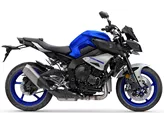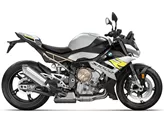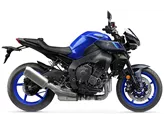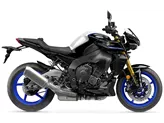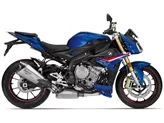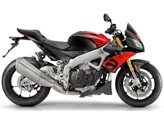Yamaha MT-10 2017 vs. BMW S 1000 R 2015

Yamaha MT-10 2017

BMW S 1000 R 2015
Overview - Yamaha MT-10 2017 vs BMW S 1000 R 2015
The Yamaha MT-10 2017 and the BMW S 1000 R 2015 are both naked bikes with similar engine types, power, torque, and cylinders. The Yamaha MT-10 has a displacement of 998 ccm, while the BMW S 1000 R has a displacement of 999 ccm. Both bikes have upside-down telescopic fork front suspension and swing arm rear suspension with a monoshock. They also have aluminum frames, with the Yamaha MT-10 having a Deltabox frame and the BMW S 1000 R having a Twin Tube frame.
In terms of brakes, both bikes have double disk front brakes. The Yamaha MT-10 has advanced rider assistance systems such as ABS and traction control, while the BMW S 1000 R has dynamic suspension as its advanced rider assistance system.

Yamaha MT-10 2017
In terms of dimensions and weights, both bikes have the same front and rear tire width and diameter. The Yamaha MT-10 has a wheelbase of 1400 mm and a seat height of 825 mm, while the BMW S 1000 R has a slightly longer wheelbase of 1439 mm and a slightly lower seat height of 814 mm. The Yamaha MT-10 also has a slightly higher kerb weight of 210 kg compared to the BMW S 1000 R's 207 kg. Both bikes have a fuel tank capacity of around 17 liters, with the BMW S 1000 R having a slightly larger capacity of 17.5 liters.
In terms of strengths, the Yamaha MT-10 2017 is praised for its great sound, pleasant wind protection, comfortable seating position even on long tours, great engine response, and balanced overall package despite its radical looks and wicked sound. On the other hand, the BMW S 1000 R 2015 is praised for its powerful and well-controllable engine, powerful braking system, and comparatively comfortable seating position.

BMW S 1000 R 2015
However, the Yamaha MT-10 2017 does have some weaknesses. Its seating position on the racetrack is considered too inactive, and its chassis and ride assistance systems are sufficient for trackdays but not on the same level as other Powernakeds. As for the BMW S 1000 R 2015, it is noted to have irresistible but expensive optional extras, a hard chassis, and vibrations in the handlebars.
In conclusion, both the Yamaha MT-10 2017 and the BMW S 1000 R 2015 have their strengths and weaknesses. The Yamaha MT-10 offers a balanced overall package with great sound and comfortable seating, while the BMW S 1000 R provides a powerful engine and braking system with a comparatively comfortable seating position. Ultimately, the choice between the two will depend on individual preferences and priorities.
Technical Specifications Yamaha MT-10 2017 compared to BMW S 1000 R 2015
Pros and Cons in comparison
Pros and Cons in comparison
Yamaha MT-10 2017

The Yamaha MT-10 exudes a lot of emotion with the cool CP4 engine, but also doesn't forget pragmatic utility. For a naked bike, it offers a lot of comfort on long tours. It rides fast but is still refined at all times. On the racetrack, the chassis is not precise enough to beat the other Powernakeds. Overall, however, it scores with its versatility paired with radical looks and awesome sound.
BMW S 1000 R 2015

With the BMW S 1000 R, you notice both the close relationship to the S 1000 RR superbike and the endeavour to equip the machine with a high degree of comfort for country roads and everyday use. Accordingly, the 1000cc four-cylinder power unit is brute and yet easily controllable, and the seating position is correspondingly sporty and comfortable. The fact that the S 1000 R is one of the most affordable power naked bikes is surprising and very pleasing, although one must not get hold of the list of optional extras - because thanks to the many irresistible features, it will certainly be more expensive.
Price Comparison Avarage Market Price Yamaha MT-10 vs BMW S 1000 R
There are a few key differences between a Yamaha MT-10 2017 and a BMW S 1000 R 2015. In terms of price, the actual average prices of both motorbikes are almost the same. A Yamaha MT-10 2017 experiences a loss of 1,010 GBP in one year and 1,700 GBP in two years of ownership. This is offset by a loss of 260 GBP and 610 GBP for a BMW S 1000 R 2015. There are the same number of bikes of both models available on the 1000PS.de marketplace, specifically 12. It takes less time to sell a BMW S 1000 R with 61 days compared to 143 days for the Yamaha MT-10. Since model year 2016 1000PS.de editors have written 32 reviews for the Yamaha MT-10 and 62 reviews for the BMW S 1000 R since model year 2014. The first review for the Yamaha MT-10 was published on 17/11/2015 and now has more than 20,700 views. This compares to more than 17,300 views for the first review on BMW S 1000 R published on 03/11/2013.



